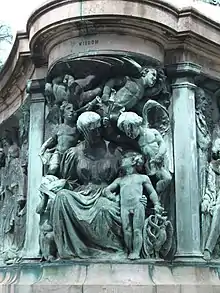Herbert Hampton (1862 – 11 February 1929)[1] was an English sculptor, artist, and creator of public memorials, who was active between 1888 and 1927.
Life
Hampton was born at Hoddesdon, Hertfordshire, and died in Great Bardfield, Essex in 1929. After education at Bishop's Stortford College, he studied art at the Cardiff School of Art, the Lambeth, the Westminster, the Slade and then the Académies Julien and Colarossi in Paris.[2] His legacy was a collection of public memorials across the United Kingdom and New Zealand.
Works

The Queen Victoria Monument in Lancaster, displays a sculpture of the queen guarded by four monumental lions, beneath them are four allegories to freedom, wisdom, truth and justice complete with a generous collection of putti; and four bas-relief friezes of fifty-three eminent Victorians, two of whom were women.
- Queen Victoria Monument, Dalton Square, Lancaster, England.[3]
- Ashton Memorial, Williamson Park, Lancaster, England
- Statue of the Duke of Devonshire, Whitehall, London
- Queen Victoria Memorial Statue (1905), Queens Gardens, Dunedin, New Zealand.[4]
- Henry Austin Bruce, Lord Aberdare (1899), New Promenade, Aberystwyth, Wales[5]
- Henry Austin Bruce, Lord Aberdare (1899), Alexandra Gardens, Cardiff, Wales
References
- ↑ Mapping Sculpture
- ↑ "Hampton, Herbert". Who's Who: 975. 1916.
- ↑ Pevsner 2009, p. 381.
- ↑ "Queen Victoria Memorial Statue - Queens Gardens, Dunedin". Heritage New Zealand Pouhere Taonga. Retrieved 16 July 2020.
- ↑ van der Krogt, René (2014). "STATUES – HITHER & THITHER". Retrieved 1 April 2017.
Sources
- Pevsner, Nikolaus (2009). Lancashire: North: the buildings of England. Yale University Press. p. 381.
- Glasgow, University of. "'Herbert Hampton', Mapping the Practice and Profession of Sculpture in Britain and Ireland 1851–1951, University of Glasgow History of Art and HATII, online database 2011". Retrieved 21 October 2014.
External links
![]() Media related to Herbert Hampton at Wikimedia Commons
Media related to Herbert Hampton at Wikimedia Commons